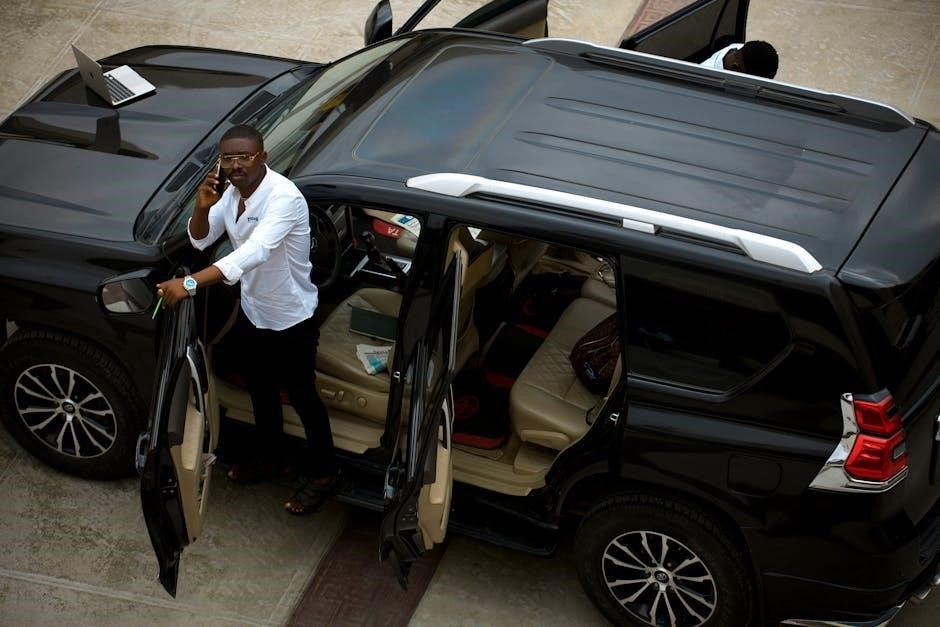
manual garage door won’t open from outside
A manual garage door that won’t open from outside can be frustrating, especially when you’re locked out․ Understanding the causes and solutions is essential for resolving the issue effectively․

Understanding the Problem
A manual garage door that won’t open from outside is a common issue, often linked to blockages, misalignment, or mechanical faults, requiring immediate attention to regain access․
Common Scenarios When the Garage Door Fails to Open Manually
When a manual garage door won’t open from outside, it often occurs due to issues like stuck rollers, misaligned tracks, or broken springs․ Another common scenario is when the emergency release mechanism fails to disengage, preventing manual operation․ Additionally, obstructions such as debris or ice can block the door’s movement․ In some cases, the locking mechanism may be engaged, or the safety sensors might be malfunctioning, further complicating the issue․ Addressing these scenarios promptly ensures quick resolution and restores accessibility․
Possible Causes of the Issue
Possible causes include faulty safety sensors, misaligned tracks, broken springs, issues with the emergency release, or problems with the locking mechanism․
Malfunctioning Safety Sensors
Malfunctioning safety sensors are a common issue that can prevent a manual garage door from opening․ These sensors, typically installed near the floor, detect obstacles and block the door from moving․ If misaligned, dirty, or damaged, they can signal the system to stop functioning․ This interference often occurs even when attempting to open the door manually․ Checking sensor alignment, ensuring they are clean, and verifying proper operation can help resolve this issue․ Faulty sensors may require adjustment or replacement to restore normal functionality․

Misalignment of the Garage Door Tracks
Misaligned garage door tracks are a common issue preventing manual operation․ The tracks guide the door’s movement, and any deviation can hinder opening․ Causes include bent tracks from accidents or loose screws․ To fix, ensure tracks are straight and securely fastened․ Cleaning debris and using a level tool can aid alignment․ Severe damage may require professional replacement to restore functionality․ Properly aligned tracks are essential for smooth door operation․
Broken or Worn-Out Springs
Broken or worn-out springs are a significant cause of manual garage doors failing to open․ Springs counterbalance the door’s weight, and their failure makes the door too heavy to lift․ Torsion or extension springs can break due to wear, rust, or accidental damage․ If springs are damaged, the door may not budge or move unevenly․ Replacing them with a new set is typically the solution, ensuring proper balance and safe operation․ Always handle springs with caution, as they can be dangerous when under tension․
Issues with the Emergency Release Mechanism
Issues with the emergency release mechanism can prevent the manual garage door from opening․ This mechanism is designed to disconnect the automatic opener, allowing manual operation․ If the mechanism is engaged, the door won’t move․ Sometimes, the release handle or cable may be faulty, causing the mechanism to malfunction․ Checking if the mechanism is properly disengaged is crucial․ If it’s stuck or damaged, it might require adjustment or replacement to restore functionality․ Ensuring this mechanism works smoothly is vital for easy manual operation during emergencies or power outages․
Locking Mechanism Problems
Locking mechanism issues can prevent the manual garage door from opening․ If the lock is engaged or jammed, it may block the door’s movement․ Sometimes, the lock can malfunction due to wear or misalignment․ In such cases, using the emergency release mechanism, which often involves a key to unlock and pull a cable, can disengage the lock․ If the locking mechanism is damaged, it may require repair or replacement․ Ensuring the lock is functioning properly is essential for smooth operation and secure access to your garage․
Tools and Equipment Needed for Troubleshooting
Essential tools include a screwdriver, wrench, pliers, and lubricant․ These help inspect and adjust components like sensors, tracks, and springs, ensuring proper door functionality and safety․
Essential Tools to Have on Hand
When addressing a manual garage door that won’t open from outside, having the right tools is crucial․ A screwdriver, wrench, and pliers are indispensable for adjusting or tightening components․ Lubricant can help resolve sticking parts, while a flashlight may illuminate hidden issues; Gloves and safety goggles protect during repairs․ Additionally, a ladder may be necessary for reaching high mechanisms, and a multimeter can diagnose electrical problems if the opener is involved․ These tools ensure you’re prepared to tackle common fixes safely and effectively․

Troubleshooting Steps
Begin by checking safety sensors, inspecting door tracks, assessing springs, evaluating the emergency release mechanism, and examining the locking system to identify the root cause efficiently․
Checking the Safety Sensors
First, ensure the safety sensors are clean and properly aligned․ Dirt, debris, or misalignment can disrupt their function, preventing the door from opening․ Use a soft cloth to clean the sensors and adjust their position if necessary․ Refer to the user manual for specific instructions on testing and realigning them․ If the issue persists, consider replacing faulty sensors to restore proper operation․ This step is crucial for both manual and automatic functionality․
Inspecting the Door Tracks for Alignment
Inspect the garage door tracks for proper alignment and obstructions․ Use a level to ensure they are straight and secure․ Clean any debris or dirt that may interfere with the door’s movement․ If the tracks are bent or misaligned, gently hammer them back into place or tighten loose bolts․ Misaligned tracks can prevent the door from opening smoothly, so precise adjustment is crucial for proper functionality․ Regularly checking and maintaining the tracks helps avoid future issues․
Assessing the Condition of the Springs
Garage door springs play a crucial role in counterbalancing the door’s weight․ Inspect the springs for signs of wear, rust, or breaks․ Use a ladder and gloves for safety․ If a spring is broken or sagging, the door will be difficult to open manually․ Check both springs, as they typically wear out together․ Avoid attempting repairs without professional help, as springs under tension can be dangerous․ If damage is found, replacement is necessary to restore proper functionality and ensure safe operation․
Evaluating the Emergency Release Mechanism
Check the emergency release mechanism, often a red handle with a rope or cable, to see if it’s engaged or jammed․ If engaged, it locks the door in place, preventing manual opening․ Locate the mechanism near the door’s track or operator․ Gently pull the release cord to disengage it․ Ensure no obstructions block the cable from moving freely․ If the mechanism is faulty or rusted, it may need lubrication or replacement․ Consulting a professional is advisable if the issue persists after disengaging the release․
Examining the Locking Mechanism
Inspect the locking mechanism to ensure it’s not engaged or jammed․ A stuck or rusted lock can prevent the door from opening․ Check for alignment issues between the lock and the receiving bracket․ Lubricate the lock if it’s stiff or corroded․ If the lock is broken or worn out, consider replacing it․ Ensure the lock is fully disengaged before attempting to open the door manually․ If the problem persists, consult a professional to avoid further damage to the door or locking system․

Solutions to the Problem
Effective solutions involve adjusting sensors, aligning tracks, repairing springs, or engaging emergency releases․ Fixing the locking mechanism often resolves the issue․ Professional help is advisable if problems persist․
Adjusting or Replacing Safety Sensors
Malfunctioning safety sensors can prevent your garage door from opening manually․ Check for proper alignment and cleanliness․ Misaligned sensors may need adjustment, while faulty ones should be replaced․ Ensure the sensors are free from debris and obstructions․ Refer to the manual for specific instructions․ If issues persist, consider consulting a professional to avoid further complications․ Properly functioning sensors are crucial for both manual and automatic operation․
Aligning the Garage Door Tracks
Misaligned garage door tracks can prevent smooth operation․ Inspect the tracks for damage or bending․ Loose tracks can be tightened by adjusting the bolts․ If tracks are bent, straightening them may resolve the issue․ Ensure proper alignment by checking the vertical and horizontal levels․ If severely damaged, consider replacing the tracks․ Regular maintenance helps prevent misalignment, ensuring the door opens and closes effortlessly from outside․
Repairing or Replacing Springs
Garage door springs are critical for counterbalancing the door’s weight․ If they’re broken or worn, the door won’t open manually from outside․ Inspect the springs for gaps or visible damage․ For torsion springs, check the tension and ensure they’re properly wound․ Extension springs may need reattachment or replacement․ Use spring clamps to secure loose ends temporarily․ If springs are severely damaged, replace them with new ones․ Always exercise caution, as springs under tension can be hazardous․ Regular lubrication and inspection can prevent spring failure and ensure smooth operation․
Engaging the Emergency Release Mechanism
The emergency release mechanism allows manual operation of the garage door when the opener fails․ Locate the cord or handle attached to the door’s spring system․ Pull it gently but firmly to disengage the door from the opener․ This releases the tension, enabling manual opening․ Ensure the door is balanced to avoid sudden movement․ If the mechanism is damaged or unclear, consider installing a quick-release kit or consulting a professional for safe and effective operation․
Fixing or Replacing the Locking Mechanism
If the locking mechanism is faulty, it can prevent the garage door from opening manually․ Check for jams, rust, or misalignment in the lock․ Lubricate the lock to ensure smooth operation․ If damaged, replace the locking mechanism with a compatible model․ Ensure proper alignment during installation to avoid future issues․ Regular maintenance, such as cleaning and lubricating, can prevent locking problems and ensure the door functions smoothly from both inside and outside․
Preventive Measures
Regular lubrication of hinges and rollers, along with annual inspections of springs and tracks, can prevent future issues with your manual garage door’s operation from outside․
Regular Maintenance to Avoid Future Issues
Regular maintenance is crucial to prevent a manual garage door from malfunctioning․ Lubricate hinges and rollers annually to ensure smooth operation․ Inspect springs for wear and tear, replacing them if necessary․ Clean tracks regularly to remove dirt and debris that could cause misalignment․ Check the emergency release mechanism to ensure it functions properly․ Schedule annual professional inspections to identify potential issues early․ By addressing these areas, you can avoid unexpected problems and keep your garage door operating efficiently for years to come․
Addressing a manual garage door that won’t open from outside involves identifying and resolving issues like misaligned tracks, faulty springs, or malfunctioning sensors․ Regular maintenance, such as lubricating hinges and inspecting cables, can prevent future problems․ If troubleshooting doesn’t work, engaging the emergency release mechanism or seeking professional help may be necessary․ By understanding the root cause and applying the right solution, homeowners can restore functionality and ensure convenient access to their garage․